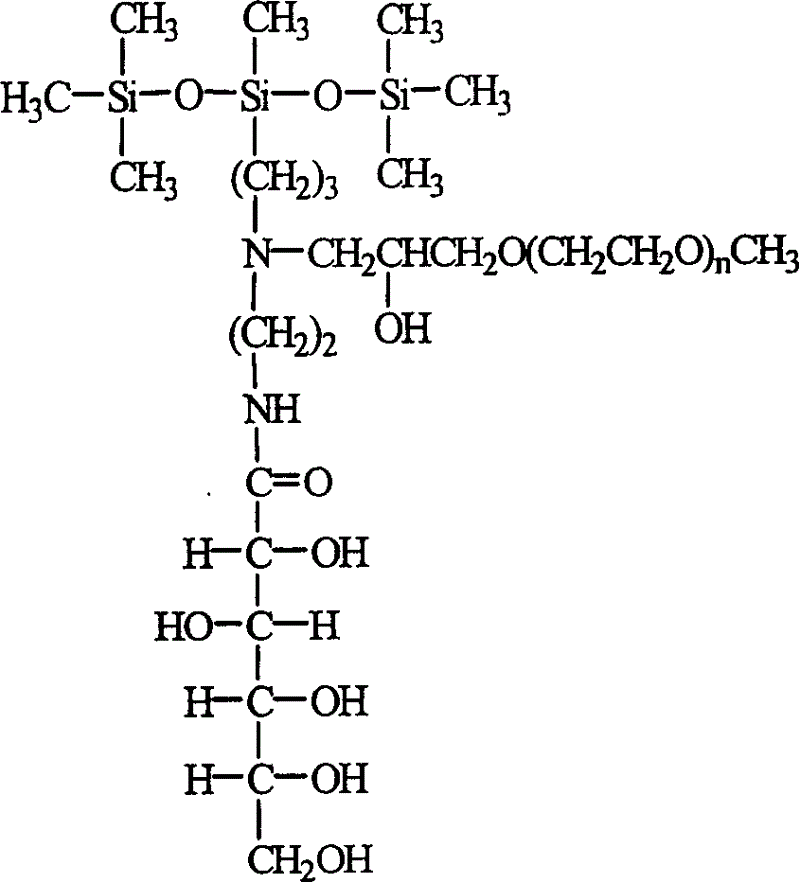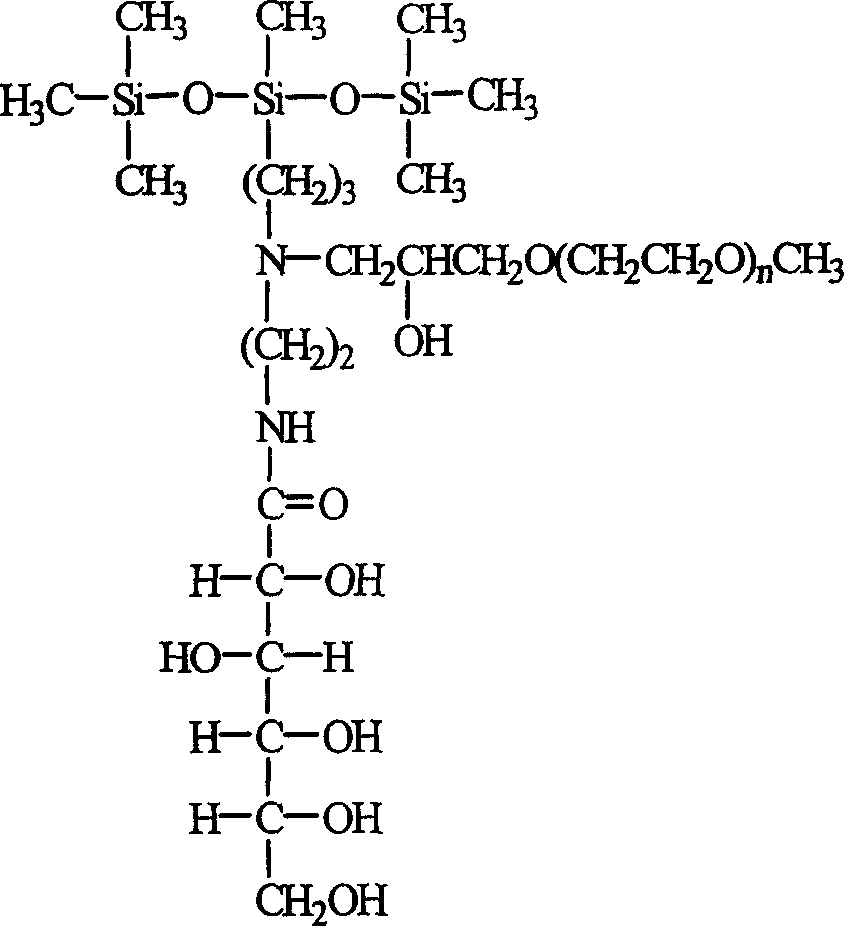Polyglycol modified trisilicate containing glucose amide group and preparation method
A technology containing glucosamide group and modified with polyethylene glycol, applied in the direction of sugar derivatives, organic chemistry, etc., can solve problems such as unreported preparation methods, and achieve the effects of cheap catalyst, good spreadability, and avoidance of toxicity
- Summary
- Abstract
- Description
- Claims
- Application Information
AI Technical Summary
Problems solved by technology
Method used
Image
Examples
Embodiment 1
[0019] Add 1.62kg of hexamethyldisiloxane, 2.06kg of aminoethylaminopropyldimethoxymethylsilane, and 1.82g of tetramethylammonium hydroxide into the reaction kettle, dissolve by heating, and control the temperature at 100℃ to react After 4 hours, the temperature was increased and heated to 130°C to deactivate the catalyst. Distill off aminoethylaminopropyltrisiloxane under reduced pressure, add equimolar gluconolactone, use methanol as solvent, heat to reflux, and react for 8 hours. Then, an equimolar amount of ethylene glycol methyl ether glycidyl ether was added, and the reaction was continued for 12 hours. The product is obtained by evaporating the solvent methanol. The lowest surface tension of its aqueous solution measured with K12 surface tension meter is 20.2mN / m, and the critical micelle concentration is 2.5×10 -4 mol / L, the minimum contact angle on the quartz surface is 5°.
Embodiment 2
[0021] Add 8.10kg of hexamethyldisiloxane, 2.34kg of aminoethylaminopropyl diethoxymethylsilane, and 168g of potassium hydroxide into the reaction kettle, and dissolve by heating. The temperature is controlled at 120°C. After 5 hours of reaction, Add acetic acid to neutralize the catalyst to deactivate it, and then evaporate unreacted hexamethyldisiloxane. Distill off aminoethylaminopropyltrisiloxane under reduced pressure, add equimolar gluconolactone, use methanol as solvent, heat to reflux, and react for 10 hours. Then, an equimolar amount of diethylene glycol methyl ether glycidyl ether was added, and the reaction was continued for 12 hours. The product is obtained by evaporating the solvent methanol. The lowest surface tension of the aqueous solution measured with K12 surface tension meter is 20.6mN / m, and the critical micelle concentration is 1.4×10 -4 mol / L, the minimum contact angle on the quartz surface is 18°.
Embodiment 3
[0023] Add 16.20kg of hexamethyldisiloxane, 2.06kg of aminoethylaminopropyldimethoxymethylsilane, and 151.8g of tetrabutylphosphonium hydroxide into the reaction kettle, dissolve by heating, control the temperature at 80℃, and react for 4 hours After that, the temperature was increased and heated to 110° C. to deactivate the catalyst, and at the same time, unreacted hexamethyldisiloxane was evaporated. Distill off aminoethylaminopropyltrisiloxane under reduced pressure, add equimolar gluconolactone, use methanol as solvent, heat to reflux, and react for 8 hours. Then, an equimolar amount of triethylene glycol methyl ether glycidyl ether was added, and the reaction was continued for 12 hours. The product is obtained by evaporating the solvent methanol. The lowest surface tension of its aqueous solution measured with K12 surface tension meter is 20.7mN / m, and the critical micelle concentration is 6×10 -5 mol / L, the minimum contact angle on the quartz surface is 15°.
PUM
| Property | Measurement | Unit |
|---|---|---|
| surface tension | aaaaa | aaaaa |
| surface tension | aaaaa | aaaaa |
| surface tension | aaaaa | aaaaa |
Abstract
Description
Claims
Application Information
 Login to View More
Login to View More - R&D
- Intellectual Property
- Life Sciences
- Materials
- Tech Scout
- Unparalleled Data Quality
- Higher Quality Content
- 60% Fewer Hallucinations
Browse by: Latest US Patents, China's latest patents, Technical Efficacy Thesaurus, Application Domain, Technology Topic, Popular Technical Reports.
© 2025 PatSnap. All rights reserved.Legal|Privacy policy|Modern Slavery Act Transparency Statement|Sitemap|About US| Contact US: help@patsnap.com


